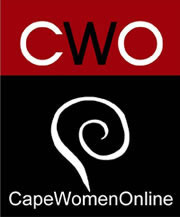CapeWomenOnline - Where Cape Women Shine
Your local venue for the women of Cape Cod to share their ideas, experiences and resources while inspiring each other in their life's journey
Inspire . Encourage . Network . Share
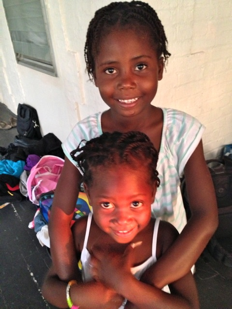
Bringing Haiti Home: Ellen LeBow Opens Her Home And Her Heart
by Ellen Raquel LeBow
The other day the two 10-year-old Haitian girls Seth and I recently brought home to live with us had an announcement: Because people found their names too difficult to pronounce Hernitte Riviere and Woodmyha Rafa Luma had decided to change their names to "Linda" and "Lindi".
This was one change of many for them. Their shift from life in rural Haiti to Cape Cod has been a learning curve still arcing towards its pinnacle, but they have taken it on with grace and sharp-eyed wonder.
The daily differences could not be more extreme: The girls, our goddaughters, came from Matènwa, a remote mountain village of poor farming families.
Matènwa is a close–knit community. The girls have many sisters and brothers and rich cultural traditions. Yet they grew up with no drivable roads, running water, cars, electricity, or doctors.
Matènwa is trying to lift itself from poverty, even as its survival is suffering under the blows of environmental ruin and political neglect. But change can't be rushed and right now there's no easy access to higher education or broader life choices for bright young girls.
On Cape Cod, Woodmyha and Hernitte are delirious in their discovery of vast bodies of fresh water, flowers and pizza. They are at once excited and ambivalent about learning English; shy about making mistakes, fearful it will make them forget Creole and so not be able to speak with their sisters in Haiti, yet knowing language is their access to the new world expanding exponentially around them.
I fear for them too. I fear their hearts' temporary loss of culture and family. I fear the racism that will shock them someday. But when I put fear and opportunity side-by-side opportunity weighs more.
Bringing the girls home is one step among thousands that tie Wellfleet, Cape Cod to Matènwa, Haiti.
It began 16 years ago when Chris Low, the co-director of Matènwa's progressive community school, invited me to bring some art-making ideas to the villagers. My past experiences in Haiti had compelled me to get closer to this fierce and complex country, so with that school's offer, I took a blind leap.
Without a goal in mind beyond having an experience, I walked, like Woodmyha and Hernitte, into a different way of living. Priorities, manners, entertainment, food, language, gestures, jokes, expectations, even color and light were things I had to re-understand in the context of where I was.
I knew the tormented history of Haiti's birth. I knew the depths of its spiritual links to Africa, changed and inflamed by slavery. I'd seen the astounding hardship of physical everyday life, but never with such immediacy. It was woven into every religious practice, every tenderness and brutality, every choice a Haitian family made.
Children and animals worked alongside adults. Dust and rocks were the medium in which our lives moved. Rough farming and carrying water ate up peoples' daylight hours. There was no visual art in the lives of the very poor. No one owned a pencil.
But there was an innate creative desire.
At first I was terrified, then amazed, by the voracity of the children who poured out the school gates and into our little makeshift "art center" every afternoon, as hungry for art-making as the adults. We had nothing but pencils, glue, cement bags, copy paper and a little paint, but it didn't matter, everyone was ready to make an image.
It was this type of hunger that drew me back. As an artist, the elemental urge to express what you know and find honor in what you'd done is a virtue I felt compelled to feed. They showed me it was not a privilege but a human right that roots its way through all political, class and cultural divides.
But alongside the need for art where there isn't any is the need for money where there isn't any.
Money: that lack between you and food, clothes, medicine, education, and a peaceful home. If we could marry earning to art making, Chris and I thought, how sweet a union would THAT be?
Women kept the families together. By the end of my first stay it was clear that an artistic skill Matènwa's women could enjoy learning – producing a product we could bring back and sell - could help them stabilize their lives.
The technique had to be low-tech, expressively satisfying, easy to transport, and could not waste scarce local resources like wood and water. Within a year we had eight mothers painting silk scarves on Chris' veranda. She showed them how to keep business records and I helped design and refine images.
By the next year the first group taught their craft to six more women and the year after that a substantial grant helped us build our own "Sant Atizana," Creole for Arts Center. Demand for a place in the group became overwhelming. Every day women walked miles to leave letters begging to join the Sant.
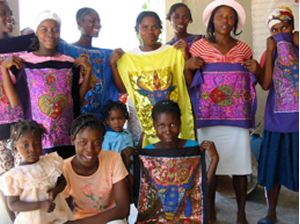
To meet their needs we eventually expanded until we had 45 artists silk painting, embroidering, beading, printmaking and drawing.
Organizing such a big place was going to be crucial to its success.
Principles had to be developed and voted into place. We depended on cooperation, respect for tools and materials mattered. Any form of violence was forbidden and participants and their children had to stay in school. Managers had to be elected and a managing committee established. Materials had to be stored and regulated, quality had to be kept up.
Big growth was not without problems. More artists meant more products that needed to be sold.
The American market, fickle world economy and private fundraising were not dependable year to year and often the artists had long stretches without work or money.
Materials not found locally have to be brought over by us, or anyone we could cajole into making the long and difficult journey to Matènwa.
And the earthquake of 2010 took its expensive toll on the homes of the artists' families.
Still, the project attracted more and more Cape Cod visionaries.
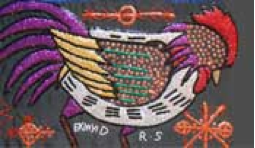
RaRa
55 Commercial Street, Wellfleet MA
Fall Store Hours
10:30-1:30 & 4:30-7
This year we unveiled our newest achievement and hope for the Matènwa women's sustaining success: www.artmatenwa.org
A website rich with photos, artist profiles, video, donation options, blog and easy access to the artists' work both "classic" and new.
Nauset High School teachers Lisa Brown and Valerie Bell have brought music, science and high school students to Matènwa for over a decade. Brewster's Arielle Berrick helped the artists organize the repair of their earthquake-damaged homes and continues to act as a liaison between the artists and us.
The most important aspect of our connection to Haiti is the overwhelming encouragement and generosity of Cape Codders.
They've made our annual fundraising "Merci D'Avance Dance" party an outer Cape dead-of-winter tradition, and support RaRa, our seasonal Wellfleet outlet offering a hands-on experience of the artists' work.
The other day, in the kitchen, Hernitte and Woodmyha enacted their future triumphant return to Matènwa as swaggering grownups, fluent in English and swimming, leading me, by then an old woman, hobbling along with two canes. They said it's they who, soldier-like, will be taking charge of the art center.
They want their little sisters' lives to be different.
Photographs courtesy of Ellen LeBow
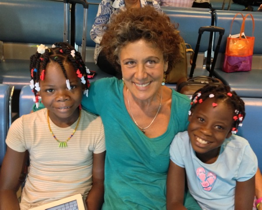
Ellen Raquel LeBow is an artist from Wellfleet and Cambridge, MA who shows at the Rice/Polak Gallery in Provincetown.
She is the coordinator of ART/MATENWA and RARA, a local project that works to bring sustainability through art to women in the village of Matènwa. Haiti, and is on the founding board of Wellfleet Preservation Hall.
She lives in Wellfleet with her long time partner Seth Rolbein and their two goddaughters Hernitte Riviere and Woodmyha Rafa Luma.
To learn more about Ellen's work in Haiti visit:
www.artmatenwa.org
